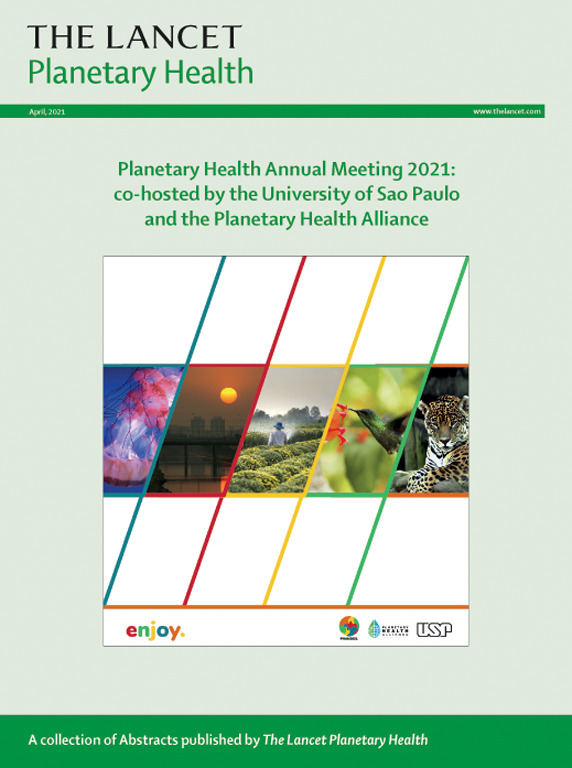Impact of climate change on arsenic concentrations in paddy rice and the associated dietary health risks in Asia: an experimental and modelling study
IF 21.6
1区 医学
Q1 ENVIRONMENTAL SCIENCES
引用次数: 0
Abstract
Background
Rising global atmospheric carbon dioxide (CO2) concentrations and surface temperatures could negatively affect rice yields and nutritional quality; however, their effects on arsenic accumulation in paddy rice have not been assessed concurrently. We aimed to assess the impact of increases in CO2 and temperature (individually and in combination) on arsenic concentrations in rice, characterise soil properties that might influence arsenic uptake, and model the associated risks of cancer and other health outcomes due to increased arsenic exposure.
Methods
For this modelling study we performed in-situ multi-varietal trials using Free-Air CO2 Enrichment platforms with and without supplemental temperature to examine the bioaccumulation of arsenic in paddy rice and the underlying biogeochemical mechanisms from 2014 to 2023. We modelled dietary inorganic arsenic exposure and the associated risks of cancer and non-cancer health outcomes via rice consumption for seven of the leading rice-consuming countries in east and southeast Asia.
Findings
Concomitant increases in CO2 and temperature resulted in a synergistic increase of inorganic arsenic in rice grain. The observed increase is likely to be related to changes in soil biogeochemistry that favoured reduced arsenic species. Modelled consumption of rice under these conditions resulted in projected increases in inorganic arsenic exposure and lifetime cancer and health risks for multiple Asian countries by 2050.
Interpretation
Inorganic arsenic exposure and the associated health consequences might increase in rice grain grown in flooded systems with mid-century climate projections. The current assessment reinforces the urgent need for mitigation of arsenic exposure in rice relative to near-term climate change.
Funding
National Key Research and Development Program of China, National Natural Science Foundation of China, Key-Area Research and Development Program of Guangdong Province, China, Carbon Peaking and Carbon Neutrality Special Fund for Science and Technology from Nanjing Science and Technology Bureau, Key Research and Development Program of Jiangsu Province, Erdos City Science and Technology Major Project, Science Foundation of the Chinese Academy of Sciences, Carbon Peaking and Carbon Neutrality Special Fund for Science and Technology from Jiangsu Science and Technology Department, and “0-1” Original Innovation Project of the Chinese Academy of Sciences.
气候变化对亚洲水稻中砷浓度的影响及相关的饮食健康风险:一项实验和模型研究
背景:全球大气二氧化碳浓度和地表温度上升可能对水稻产量和营养品质产生负面影响;然而,它们对水稻中砷积累的影响尚未得到评价。我们的目标是评估二氧化碳和温度的增加(单独和联合)对水稻中砷浓度的影响,描述可能影响砷吸收的土壤特性,并模拟由于砷暴露增加而导致的癌症和其他健康结果的相关风险。方法:在2014年至2023年期间,我们在有和没有补充温度的自由空气CO2富集平台上进行了多品种原位试验,以研究水稻中砷的生物积累及其潜在的生物地球化学机制。我们通过东亚和东南亚七个主要大米消费国的大米消费,模拟了饮食中无机砷暴露以及相关的癌症和非癌症健康结果风险。研究发现,CO2和温度的同时升高导致水稻籽粒中无机砷的协同增加。所观察到的增加很可能与土壤生物地球化学的变化有关,这些变化有利于减少砷的种类。在这些条件下模拟的大米消费导致预计到2050年多个亚洲国家无机砷暴露和终生癌症和健康风险增加。根据本世纪中叶的气候预测,在洪水系统中种植的水稻中,无机砷暴露及其相关的健康后果可能会增加。目前的评估强调了在近期气候变化的影响下,迫切需要减少水稻中的砷暴露。国家重点研究与发展计划,国家自然科学基金,广东省重点地区研究与发展计划,南京市科技局碳峰值与碳中和科技专项基金,江苏省重点研究与发展计划,鄂尔多斯市科技重大项目,中国科学院科学基金,江苏省科技厅碳调峰与碳中和科技专项基金,中科院“0-1”原始创新项目。
本文章由计算机程序翻译,如有差异,请以英文原文为准。
求助全文
约1分钟内获得全文
求助全文
来源期刊

Lancet Planetary Health
Multiple-
CiteScore
28.40
自引率
2.30%
发文量
272
审稿时长
8 weeks
期刊介绍:
The Lancet Planetary Health is a gold Open Access journal dedicated to investigating and addressing the multifaceted determinants of healthy human civilizations and their impact on natural systems. Positioned as a key player in sustainable development, the journal covers a broad, interdisciplinary scope, encompassing areas such as poverty, nutrition, gender equity, water and sanitation, energy, economic growth, industrialization, inequality, urbanization, human consumption and production, climate change, ocean health, land use, peace, and justice.
With a commitment to publishing high-quality research, comment, and correspondence, it aims to be the leading journal for sustainable development in the face of unprecedented dangers and threats.
 求助内容:
求助内容: 应助结果提醒方式:
应助结果提醒方式:


